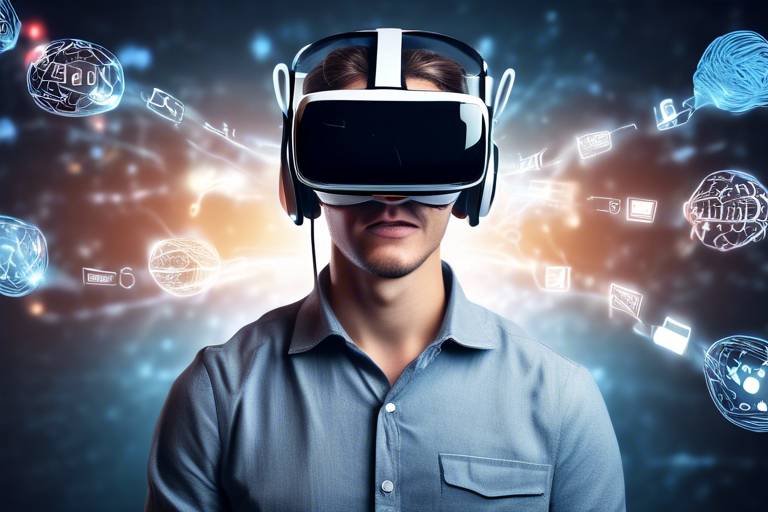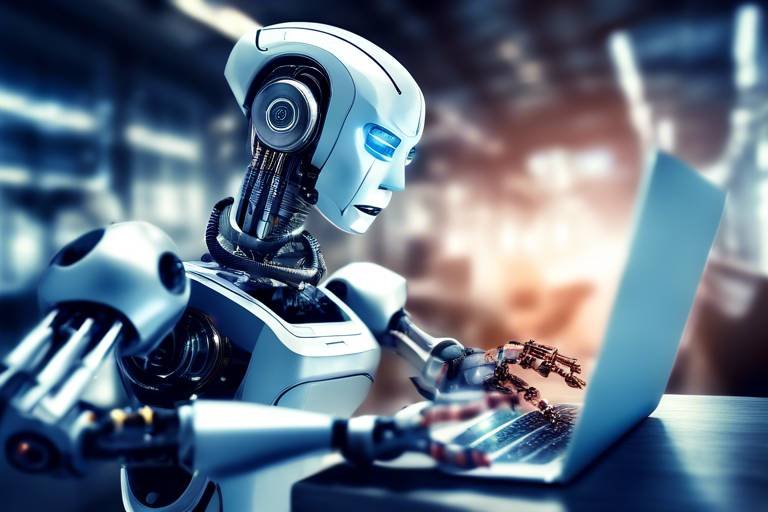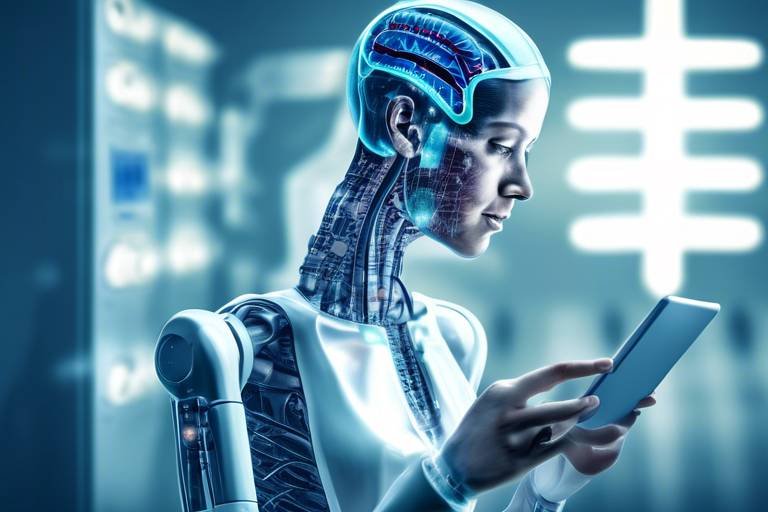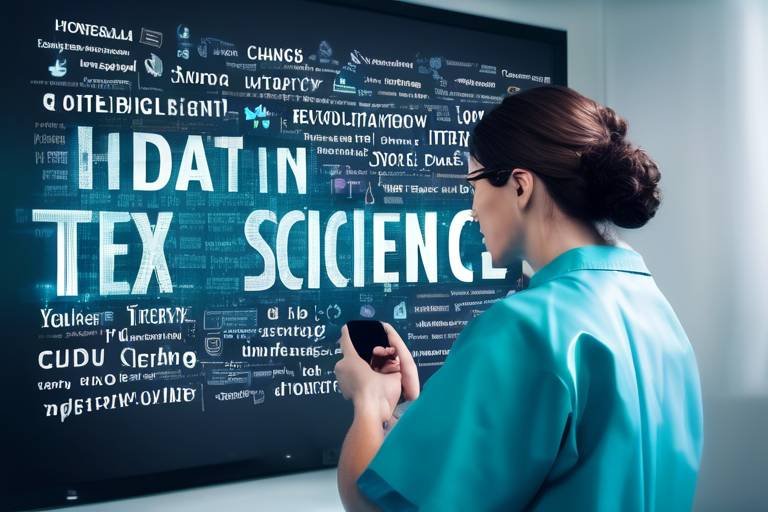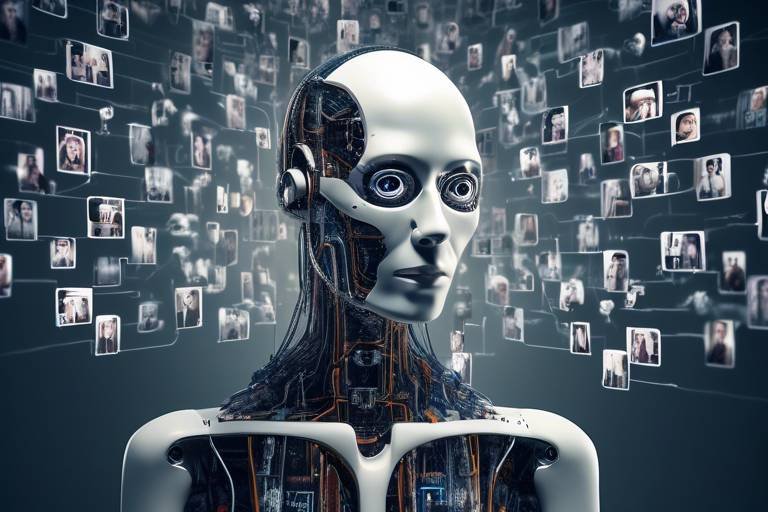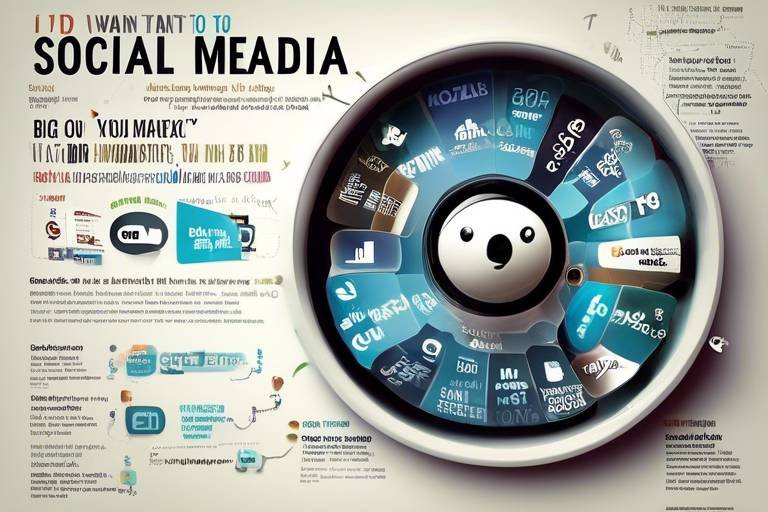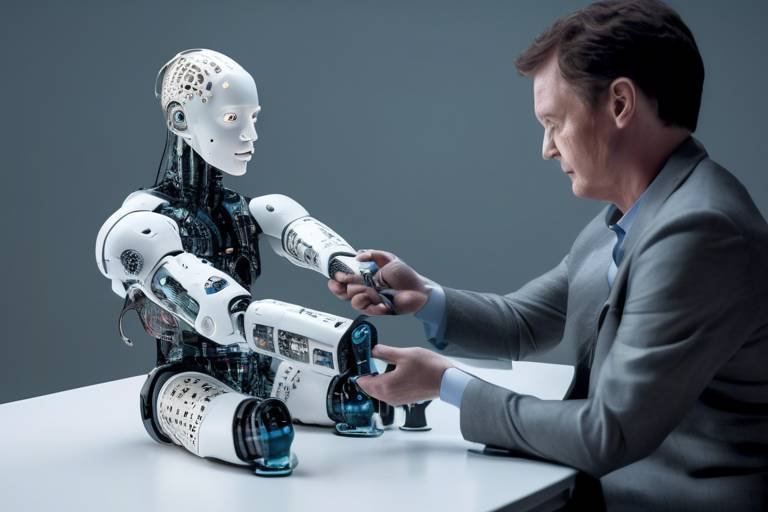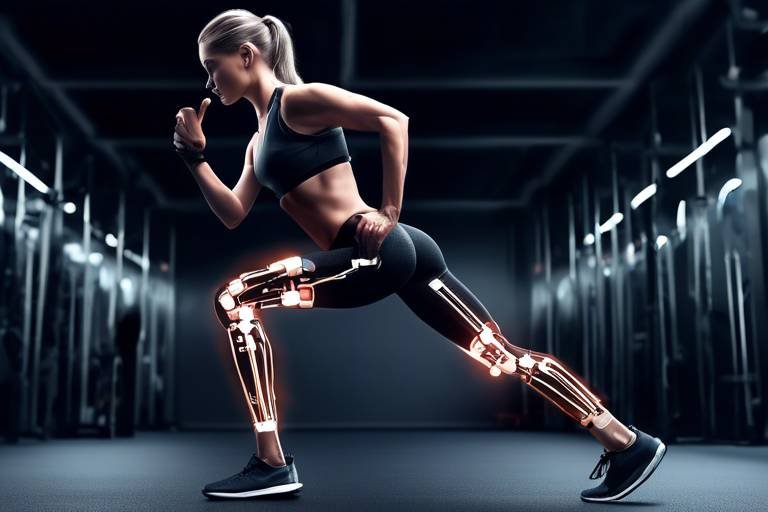The Future of E-learning: The Role of VR & AI
The world of education is on the brink of a profound transformation, thanks to the integration of Virtual Reality (VR) and Artificial Intelligence (AI). These technologies are not just buzzwords; they are reshaping how we learn and teach, making education more engaging, personalized, and accessible than ever before. Imagine stepping into a virtual classroom where you can interact with 3D models, or having a personal AI tutor that understands your learning style and adapts to your needs. Sounds intriguing, right? This article delves into the innovative trends, benefits, challenges, and future possibilities that VR and AI bring to the e-learning landscape.
Virtual Reality is revolutionizing educational experiences by providing immersive environments that enhance learning. Picture this: instead of reading about ancient civilizations, students can don VR headsets and walk through the streets of Rome or the pyramids of Egypt. This level of interaction not only captivates students but also helps them retain information better. VR technology is being integrated into classrooms in various ways, from virtual field trips to simulations that allow students to practice real-world skills in a safe environment. The potential to engage students through immersive experiences is limitless, making learning not just a task but an adventure.
On the other hand, AI is reshaping the educational landscape by offering personalized learning experiences tailored to each student’s unique needs. Have you ever wished for a tutor who could adjust lessons based on your strengths and weaknesses? That's precisely what AI can offer. By analyzing students’ performance and learning patterns, AI algorithms can adapt educational content, ensuring that each learner progresses at their own pace. This not only improves learning outcomes but also keeps students engaged and motivated.
Adaptive learning platforms leverage AI to customize educational content to fit each student's pace and style. These platforms function by assessing a student’s knowledge level and adjusting the difficulty of tasks accordingly. For instance, if a student struggles with a particular math concept, the system will offer additional resources and practice problems tailored to that topic. This personalized approach significantly enhances student success, as learners are more likely to grasp concepts when they are presented in a way that resonates with them.
AI systems analyze vast amounts of data to provide insights into student performance, enabling educators to refine their teaching strategies. Imagine a teacher receiving a detailed report on each student's progress, identifying areas where they excel and where they might need extra help. This data-driven approach allows educators to support individual learners more effectively, ensuring that no student is left behind. By harnessing these insights, teachers can create a more dynamic and responsive learning environment.
Chatbots powered by AI are becoming increasingly common in educational settings, offering instant support and resources to students. Think of them as your 24/7 study buddies, ready to answer questions or provide guidance whenever you need it. These chatbots can assist with everything from homework help to administrative inquiries, improving student engagement and accessibility to information. By providing quick answers and resources, chatbots free up educators to focus on more complex teaching tasks, ultimately enhancing the overall educational experience.
While the benefits of VR and AI in education are significant, their implementation does come with challenges. Technical issues, financial constraints, and ethical considerations can pose hurdles for educators looking to adopt these technologies. For instance, the cost of VR equipment can be prohibitive for some institutions, and ensuring that all students have access to the necessary technology is crucial for equitable learning experiences. Moreover, educators must navigate data privacy concerns when utilizing AI systems that collect and analyze student data. Addressing these challenges is essential to fully realize the potential of VR and AI in education.
Looking ahead, the future of e-learning is bright with advancements in VR and AI. Emerging trends indicate that these technologies will continue to evolve, shaping the educational landscape in exciting ways. For example, we may see the development of more sophisticated VR environments that allow for collaborative learning experiences, where students from different parts of the world can interact in real-time.
The integration of VR and AI with traditional learning methods enhances educational experiences. Hybrid models that combine conventional teaching with modern technology are becoming increasingly popular. This approach allows educators to leverage the strengths of both methods, creating a more well-rounded learning environment that caters to diverse learning styles.
Finally, VR and AI have the potential to make education more accessible to diverse populations. These technologies can bridge gaps and promote inclusivity in learning environments, ensuring that all students, regardless of their background or abilities, have the opportunity to succeed. By breaking down barriers to education, we can create a more equitable future for learners everywhere.
- What is the role of VR in education? VR provides immersive learning experiences that enhance engagement and retention.
- How does AI personalize learning? AI adapts educational content based on individual student performance and learning styles.
- What are adaptive learning platforms? These platforms use AI to tailor educational experiences to each student's needs.
- What challenges come with implementing VR and AI in education? Challenges include technical issues, financial constraints, and ethical concerns regarding data privacy.
- How can VR and AI promote inclusivity in education? They can provide accessible learning experiences for diverse populations, bridging gaps in education.

The Rise of Virtual Reality in Education
In recent years, virtual reality (VR) has emerged as a game-changer in the field of education, transforming how students engage with learning materials. Imagine stepping into a 3D world where you can explore the depths of the ocean, walk through ancient civilizations, or even conduct complex scientific experiments—all from the comfort of your classroom. This immersive experience not only captivates students' attention but also enhances their ability to retain information. With VR, the classroom becomes a dynamic learning environment that transcends traditional boundaries.
One of the most exciting aspects of VR in education is its ability to create interactive simulations. For instance, medical students can practice surgical procedures in a risk-free environment, while history students can experience pivotal moments in time. This hands-on approach to learning fosters a deeper understanding of the subject matter, making it more relatable and engaging. Furthermore, VR technology can cater to various learning styles, allowing visual, auditory, and kinesthetic learners to thrive.
As schools begin to integrate VR into their curricula, the impact on student engagement is palpable. Studies have shown that students who participate in VR-based learning experiences exhibit higher levels of motivation and enthusiasm. They are not just passive recipients of information; rather, they become active participants in their education. This shift in engagement can lead to improved academic performance and a greater love for learning.
However, the implementation of VR in education is not without its challenges. Schools face significant hurdles, including the high cost of VR equipment and the need for teacher training. Additionally, there are concerns about accessibility, as not all students may have equal access to the technology. To address these issues, educational institutions must collaborate with tech companies and policymakers to create affordable solutions and ensure that VR is available to all students, regardless of their socioeconomic background.
In conclusion, the rise of virtual reality in education is not just a passing trend; it represents a fundamental shift in how we approach learning. As technology continues to evolve, we can expect VR to play an increasingly prominent role in classrooms around the world. By embracing this innovative tool, educators can create a more engaging, effective, and inclusive learning environment for all students.

Artificial Intelligence: Personalizing Learning
Artificial Intelligence (AI) is not just a buzzword; it's a game changer in the world of education. Imagine a classroom where every student receives a tailored learning experience that caters specifically to their needs, strengths, and weaknesses. Sounds like a dream, right? Well, with AI, this dream is becoming a reality. By harnessing the power of algorithms and data analysis, AI is reshaping how we approach education, making it more personalized and effective than ever before.
One of the most exciting aspects of AI in education is its ability to adapt to individual learning styles. Think of it as having a personal tutor available 24/7. AI systems analyze how students interact with educational content, identifying patterns and preferences. This allows them to adjust the curriculum dynamically, ensuring that each learner is challenged appropriately. For example, if a student excels in mathematics but struggles with reading comprehension, the AI can provide more math challenges while offering additional resources for reading.
In addition to adapting content, AI also plays a crucial role in monitoring progress. By continuously assessing student performance through quizzes, assignments, and participation, AI can generate data-driven insights that help educators understand where their students are excelling and where they may need extra support. This is particularly beneficial in large classrooms where individual attention can be challenging to provide. With AI, teachers can focus their efforts on students who need it most, enhancing overall learning outcomes.
Adaptive learning platforms are at the forefront of this AI revolution. These platforms utilize sophisticated algorithms to create a personalized learning path for each student. They don’t just adjust the difficulty of tasks; they also curate resources that align with a student's interests. For instance, a student passionate about space exploration might receive articles and videos related to astronomy, while another interested in history could be directed to content about ancient civilizations. This not only keeps students engaged but also fosters a deeper love for learning.
To illustrate the impact of these adaptive platforms, consider the following table showcasing the differences between traditional learning methods and adaptive learning:
| Aspect | Traditional Learning | Adaptive Learning |
|---|---|---|
| Learning Pace | Uniform for all students | Individualized based on student needs |
| Content Delivery | One-size-fits-all | Custom-tailored resources |
| Feedback | Periodic assessments | Real-time feedback and adjustments |
| Engagement | Passive learning | Interactive and engaging |
As we dive deeper into the AI landscape, it's essential to address the role of chatbots in education. These AI-powered assistants are becoming increasingly common in educational settings, providing students with instant support. Need help with a math problem at midnight? Chatbots are there to guide you through it. They can answer questions, provide resources, and even help with scheduling study sessions. This level of accessibility is crucial in today’s fast-paced world, where students often juggle multiple responsibilities.
However, while the benefits of AI in personalizing learning are clear, it's essential to recognize the challenges that come with it. Issues such as data privacy, the digital divide, and the need for teacher training in new technologies can pose significant hurdles. But with thoughtful implementation and a focus on ethical considerations, the potential of AI in education is boundless.
- How does AI personalize learning experiences?
AI analyzes student performance and preferences to adapt content and resources, ensuring each learner receives a tailored educational experience. - What are adaptive learning platforms?
These platforms use AI algorithms to adjust the learning path for each student based on their individual progress and needs. - Can AI replace teachers?
No, AI is designed to enhance the learning experience, providing support and insights that allow teachers to focus on individualized instruction.

Adaptive Learning Platforms
Adaptive learning platforms are at the forefront of revolutionizing education by utilizing artificial intelligence to create personalized learning experiences. Imagine walking into a classroom where every lesson feels tailor-made just for you. That's the magic of adaptive learning! These platforms assess a student's unique learning style, pace, and preferences, adjusting the curriculum dynamically to meet individual needs. This isn't just a fancy tech gimmick; it's a game changer that can significantly enhance learning outcomes.
So, how do these platforms actually work? At their core, adaptive learning systems gather and analyze data from students' interactions with the material. They track progress, identify strengths and weaknesses, and use this information to modify the content accordingly. For instance, if a student struggles with algebra but excels in geometry, the platform might provide additional resources and exercises in algebra while allowing the student to advance in geometry. This kind of tailored approach not only keeps students engaged but also fosters a sense of achievement.
One of the most fascinating aspects of adaptive learning platforms is their ability to utilize various types of content. From videos and interactive simulations to quizzes and reading materials, these platforms curate a rich tapestry of resources that cater to different learning modalities. This means that whether a student learns best through visual aids, auditory lessons, or hands-on activities, the platform can deliver content in a way that resonates with them.
Moreover, adaptive learning isn't just beneficial for students; it also empowers educators. By providing data-driven insights into student performance, teachers can identify which concepts need more attention and adjust their teaching strategies accordingly. This collaborative approach between technology and educators creates a more effective learning environment where both parties can thrive.
To illustrate the impact of adaptive learning platforms, consider the following table:
| Feature | Benefits |
|---|---|
| Personalized Learning Paths | Ensures that each student learns at their own pace, reducing frustration and enhancing motivation. |
| Real-time Feedback | Provides immediate insights into student performance, allowing for quick intervention when necessary. |
| Diverse Learning Materials | Cater to various learning styles, making education more engaging and effective. |
| Data Analytics | Equips educators with valuable information to tailor their teaching strategies and improve student outcomes. |
In summary, adaptive learning platforms represent a significant leap forward in the educational landscape. By leveraging the power of AI, these platforms create a more personalized, engaging, and effective learning experience for students. As technology continues to evolve, we can only anticipate even greater innovations in this space, making education more accessible and tailored to individual needs than ever before.
- What is an adaptive learning platform? An adaptive learning platform uses technology to customize educational experiences based on individual student needs.
- How do adaptive learning platforms benefit students? They offer personalized learning paths, real-time feedback, and diverse materials tailored to different learning styles.
- Can teachers use adaptive learning platforms? Yes, educators can utilize these platforms to gain insights into student performance and adjust their teaching strategies accordingly.
- Are adaptive learning platforms suitable for all subjects? They can be applied across various subjects, from math and science to languages and arts.

Data-Driven Insights
In the rapidly evolving landscape of education, have emerged as a game-changer, empowering educators to make informed decisions that significantly enhance student learning experiences. By harnessing the power of artificial intelligence, educational institutions can analyze vast amounts of data collected from various sources, including assessments, participation rates, and even social interactions within learning platforms. This analysis not only identifies trends but also pinpoints areas where students may be struggling, allowing for timely interventions.
Imagine a classroom where teachers can instantly access a dashboard filled with real-time analytics on each student's performance. This is not merely a dream; it’s a reality made possible through AI. Educators can track metrics such as grades, engagement levels, and learning habits. For instance, if a student consistently performs poorly on quizzes but excels in group projects, the teacher can tailor support specifically to that student’s needs. This targeted approach ensures that no student is left behind, fostering a more inclusive learning environment.
Additionally, data-driven insights can inform curriculum development. By analyzing which topics students find most challenging, educators can adjust their teaching strategies or even redesign course materials to better align with student needs. This leads to a more dynamic and responsive educational framework, where learning is not static but continuously evolving based on student feedback and performance data.
| Data Metrics | Insights Gained | Actionable Strategies |
|---|---|---|
| Assessment Scores | Identify subjects where students struggle | Focus on these areas in future lessons |
| Engagement Levels | Determine which activities captivate students | Incorporate more interactive elements |
| Participation Rates | Spot trends in student involvement | Encourage participation through incentives |
Furthermore, the insights derived from data analytics extend beyond individual performance. They can also highlight broader trends across different demographics, helping educators and policymakers to understand how various factors—such as socioeconomic status or geographic location—affect learning outcomes. This knowledge is crucial for developing programs aimed at closing achievement gaps and promoting equity in education.
In conclusion, are not just beneficial; they are essential for creating a more effective and personalized learning experience. By leveraging these insights, educators can transform their teaching practices, ultimately leading to improved student success. The future of education is bright, and with AI at the helm, the possibilities are endless.
- What are data-driven insights? Data-driven insights refer to the knowledge gained from analyzing data to inform decisions and strategies in education.
- How can AI help in education? AI can analyze student data to personalize learning experiences, track performance, and provide insights for educators.
- What are the benefits of using data in education? Benefits include improved student engagement, tailored teaching methods, and the ability to identify and address learning gaps.
- Are there any challenges in implementing data-driven insights? Yes, challenges include data privacy concerns, the need for proper training, and ensuring equitable access to technology.

Chatbots in Education
In today's fast-paced digital world, chatbots are becoming a vital part of the educational landscape. Imagine a scenario where students have a personal assistant available 24/7, ready to answer their questions, provide resources, and even guide them through complex topics. This is not just a dream; it's a reality made possible by the integration of artificial intelligence in education. Chatbots are transforming the way students interact with learning materials and educators, making education more engaging and accessible.
One of the most significant advantages of chatbots in education is their ability to offer instant support. Students often find themselves stuck on a particular problem or concept, and waiting for a teacher's availability can be frustrating. With chatbots, learners can receive immediate responses to their inquiries. This not only alleviates the pressure on teachers but also empowers students to take charge of their learning journey. For example, a student struggling with a math problem can quickly type their question into a chatbot and receive step-by-step guidance, allowing them to understand the concept better without feeling lost.
Moreover, chatbots can be programmed to handle a variety of tasks that enhance the learning experience. They can:
- Provide personalized learning resources based on student inquiries and performance.
- Assist with administrative tasks, such as scheduling, reminders, and course information.
- Engage students in interactive quizzes and games, making learning more enjoyable.
Another exciting aspect of chatbots is their ability to analyze student interactions and adapt responses accordingly. This data-driven approach enables chatbots to learn from each interaction, improving their effectiveness over time. For instance, if a chatbot notices that a student frequently asks about a particular topic, it can proactively suggest additional resources or even initiate a conversation about related subjects. This level of personalization is a game-changer, as it helps students feel more connected to their learning environment.
However, the implementation of chatbots in education is not without its challenges. While they can enhance accessibility, there are concerns regarding data privacy and the quality of the information provided. Educational institutions must ensure that the data collected by chatbots is handled responsibly and that the responses generated are accurate and helpful. Additionally, there is a need for ongoing training and updates to keep the chatbot's knowledge base current, ensuring that it remains a valuable resource for students.
In conclusion, chatbots are paving the way for a more interactive and responsive educational experience. By providing instant support, personalized resources, and engaging interactions, they are not only improving student engagement but also fostering a culture of self-directed learning. As we continue to embrace technology in education, chatbots will undoubtedly play a crucial role in shaping the future of e-learning.
- What are chatbots? Chatbots are AI-driven applications that simulate human conversation, providing instant responses to user inquiries.
- How do chatbots enhance learning? They offer immediate support, personalized resources, and engage students in interactive activities.
- Are there any challenges with using chatbots in education? Yes, concerns include data privacy, the accuracy of information, and the need for regular updates.

Challenges of Implementing VR and AI
While the integration of Virtual Reality (VR) and Artificial Intelligence (AI) into the educational landscape is undoubtedly exciting, it also presents a unique set of challenges that educators and institutions must navigate. One of the primary hurdles is the cost of technology. Implementing VR systems and AI-driven platforms can require significant financial investment, not only for the technology itself but also for the training of educators and staff. Many institutions, especially those in underfunded areas, may struggle to allocate the necessary resources.
Another challenge is the technical infrastructure. VR applications often demand high-speed internet and powerful hardware, which may not be available in all schools. Imagine a classroom where students are eager to dive into a virtual world, only to find that the lagging connection hinders their experience. This technical barrier can lead to frustration and disengagement, defeating the purpose of these innovative tools.
Moreover, there are ethical considerations surrounding the use of AI in education. Issues such as data privacy and security are paramount, as AI systems collect and analyze vast amounts of student data. Schools must ensure that they comply with regulations and protect students' personal information. The idea of machines making decisions about a student's learning path raises questions about fairness and bias. If not carefully monitored, AI could inadvertently perpetuate existing inequalities in education.
Lastly, there is the challenge of teacher training. For VR and AI technologies to be effective, educators need to be adequately trained in their use. This involves not just understanding how to operate the technology, but also knowing how to integrate it into the curriculum effectively. Without proper training, even the most advanced systems can fall flat, leaving both teachers and students feeling lost. It’s akin to giving someone a high-tech spaceship without ever teaching them how to fly it.
In summary, while the potential of VR and AI in education is immense, addressing these challenges is crucial for successful implementation. Schools must create a strategic plan that considers financial, technical, ethical, and training aspects to harness the full power of these technologies. The journey may be complex, but the rewards of enhanced learning experiences are well worth the effort.
- What are the main benefits of using VR in education?
VR provides immersive learning experiences that can enhance engagement and retention of information. - How does AI personalize learning?
AI analyzes individual student data to adapt learning materials and approaches to suit each learner's needs. - What are the ethical concerns regarding AI in education?
Concerns include data privacy, security, and the potential for bias in AI algorithms. - Is VR technology accessible to all schools?
Accessibility varies; many schools face challenges related to funding and infrastructure. - How can teachers prepare for integrating VR and AI into their classrooms?
Professional development and training programs are essential for teachers to effectively use these technologies.

The Future of E-learning Technologies
The future of e-learning is an exhilarating landscape, brimming with possibilities that could redefine how we perceive education. With the rapid advancements in Virtual Reality (VR) and Artificial Intelligence (AI), the traditional classroom is evolving into a dynamic and interactive learning environment. Imagine stepping into a virtual classroom where you can explore ancient civilizations or conduct science experiments without leaving your home. This is not just a dream; it’s the reality that technology is paving the way for.
As we look ahead, one of the most exciting trends is the integration of VR and AI with traditional learning methods. This hybrid model combines the best of both worlds, allowing educators to enhance their teaching strategies while providing students with immersive experiences. For instance, a history teacher might use VR to take students on a virtual tour of the Roman Empire, while AI algorithms analyze students’ interactions to tailor follow-up lessons that cater to their individual learning styles. This seamless blend of technology and pedagogy promises to make learning more engaging and effective.
Moreover, the potential for global accessibility and inclusion is monumental. E-learning technologies can break down geographical barriers, offering quality education to students in remote areas who may not have access to traditional schools. Imagine a student in a rural village participating in the same virtual classroom as a student in a bustling city. This capability not only democratizes education but also fosters a sense of community among diverse learners. By utilizing VR and AI, educators can create inclusive learning environments that cater to various learning needs and backgrounds.
However, it’s crucial to acknowledge that with great innovation comes great responsibility. As we venture into this new educational frontier, we must address the ethical implications of using AI and VR in education. Issues such as data privacy, equity in access to technology, and the potential for over-reliance on digital tools must be carefully considered. Educational institutions will need to establish guidelines and best practices to ensure that these technologies are used responsibly and effectively.
Looking at the horizon, we can anticipate several emerging trends that will shape the future of e-learning:
- Gamification: Incorporating game elements into learning experiences to increase motivation and engagement.
- Microlearning: Delivering content in bite-sized formats for easier consumption and retention.
- Collaborative Learning: Enhancing peer-to-peer interaction through virtual platforms that allow students to work together, regardless of location.
In conclusion, the future of e-learning technologies is not just about incorporating new tools; it’s about reimagining the entire educational experience. As we embrace these advancements, we must remain committed to fostering an inclusive, ethical, and effective learning environment for all. The opportunities are endless, and the journey has only just begun.
- What is the role of VR in e-learning? VR enhances educational experiences by providing immersive environments that engage students in a way traditional methods cannot.
- How does AI personalize learning? AI algorithms analyze individual student performance and preferences, allowing for tailored content that meets their unique learning needs.
- What are the challenges of implementing VR and AI in education? Challenges include technical issues, financial constraints, and ethical considerations surrounding data privacy and access.
- Will VR and AI replace traditional teaching methods? No, they are intended to complement and enhance traditional methods, creating a more dynamic and engaging learning experience.

Integration with Traditional Learning
The integration of Virtual Reality (VR) and Artificial Intelligence (AI) with traditional learning methods is not just a trend; it's a revolutionary shift that is redefining how education is delivered. Imagine a classroom where students don VR headsets and are instantly transported to ancient civilizations, exploring the pyramids of Egypt or walking through the streets of Rome. This immersive experience captivates their attention far more than a textbook ever could. The beauty of this integration lies in its ability to create a hybrid learning environment that combines the best of both worlds—traditional pedagogy and cutting-edge technology.
One of the most significant advantages of merging VR and AI with conventional teaching is the ability to cater to diverse learning styles. Traditional classrooms often struggle to meet the individual needs of every student. However, with AI algorithms analyzing student performance in real-time, teachers can receive valuable insights into how each student learns best. For instance, if a student excels in visual learning, VR can provide visual simulations that enhance their understanding. Conversely, auditory learners can benefit from AI-generated audio lessons that explain complex concepts in a more relatable way. This tailored approach not only boosts engagement but also enhances comprehension and retention.
Another fascinating aspect of this integration is the potential for collaborative learning experiences. Students from different geographical locations can connect in a virtual classroom, working together on projects, sharing ideas, and even participating in virtual field trips. This global connectivity breaks down barriers and fosters a sense of community among learners. For example, a group of students in New York can collaborate with peers in Tokyo, exploring cultural differences and similarities through VR experiences. This not only enriches their learning but also prepares them for a world that values collaboration and global citizenship.
| Benefits of Integration | Description |
|---|---|
| Enhanced Engagement | Immersive VR experiences keep students interested and motivated. |
| Personalized Learning | AI tailors educational content to meet individual student needs. |
| Collaborative Opportunities | Students can work together across distances, fostering teamwork. |
| Real-World Applications | Students can apply their knowledge in simulated real-world scenarios. |
However, it's essential to recognize that this integration doesn't mean abandoning traditional methods altogether. Instead, it's about finding a balance that leverages the strengths of each approach. Teachers play a crucial role in this transition, guiding students through both virtual and traditional learning experiences. They can incorporate VR simulations into lessons while still utilizing classic teaching tools like lectures and discussions. This hybrid model not only enriches the educational experience but also prepares students for a future where adaptability and technological fluency are paramount.
In conclusion, the integration of VR and AI with traditional learning methods is paving the way for a more engaging, personalized, and collaborative educational landscape. As these technologies continue to evolve, they will undoubtedly transform how we teach and learn, making education more accessible and effective for all.
- How does VR enhance learning in traditional classrooms?
VR provides immersive experiences that capture students' attention and enhance their understanding of complex subjects. - What role does AI play in personalized learning?
AI analyzes individual student data to tailor educational content to their unique learning styles and paces. - Can VR and AI be used together effectively?
Yes, combining VR and AI creates a hybrid learning environment that maximizes engagement and learning outcomes. - Are there challenges in implementing these technologies?
Yes, challenges include technical issues, costs, and the need for teacher training in using these tools effectively.

Global Accessibility and Inclusion
In an increasingly interconnected world, the importance of in education cannot be overstated. With the advent of Virtual Reality (VR) and Artificial Intelligence (AI), educational barriers that once seemed insurmountable are beginning to crumble. Imagine a student in a remote village accessing the same high-quality educational materials as someone in a bustling city. This is not just a dream; it’s becoming a reality.
VR technology offers immersive experiences that transport learners to different environments, making it possible for students with disabilities or those in underserved areas to participate in learning activities that were previously out of reach. For instance, a student with mobility challenges can explore the depths of the ocean or the vastness of space without leaving their classroom. This transformative capability not only fosters engagement but also promotes a sense of belonging among students who may feel isolated due to their circumstances.
On the other hand, AI plays a crucial role in personalizing education to meet diverse needs. By analyzing individual learning patterns, AI can provide tailored resources and support, ensuring that every student, regardless of their background or abilities, has the opportunity to succeed. This adaptability is particularly beneficial for learners who require special accommodations, as AI can adjust content delivery and pace to suit their specific requirements.
Furthermore, the combination of VR and AI can enhance the inclusivity of educational content. For example, AI can translate lessons into multiple languages or provide real-time subtitles for hearing-impaired learners, making it easier for everyone to access the same information. These advancements not only promote equity but also enrich the learning experience by allowing students from various backgrounds to collaborate and share perspectives.
However, it’s essential to recognize that while the potential for accessibility and inclusion is immense, challenges remain. Not all regions have the necessary infrastructure to support advanced technologies. Issues such as internet connectivity, access to devices, and digital literacy can hinder the implementation of these tools. To truly harness the power of VR and AI in education, stakeholders must work together to address these gaps.
In conclusion, the future of education is bright with the promise of VR and AI driving . By breaking down barriers and creating equitable learning opportunities, we can ensure that every student has the chance to thrive, regardless of their circumstances. As we embrace these technologies, we must also commit to fostering an inclusive educational environment that celebrates diversity and empowers all learners.
- What is the role of VR in education? VR creates immersive learning experiences that enhance engagement and understanding.
- How does AI personalize learning? AI analyzes student data to tailor educational content to individual needs and learning styles.
- Can VR and AI help students with disabilities? Yes, these technologies provide unique opportunities for students with disabilities to access and engage with educational content.
- What challenges exist in implementing VR and AI in education? Challenges include technical issues, financial constraints, and the need for infrastructure improvements.
- How can we ensure equitable access to these technologies? Collaboration among educators, policymakers, and tech developers is essential to bridge the gaps in access and support.
Frequently Asked Questions
- What is the role of virtual reality (VR) in e-learning?
Virtual reality is transforming e-learning by creating immersive environments that engage students in a way traditional methods cannot. With VR, learners can explore complex concepts through interactive simulations, making education more engaging and effective.
- How does artificial intelligence (AI) personalize learning experiences?
AI personalizes learning by analyzing individual student data and adapting content to meet their unique needs. This means that students can learn at their own pace, receiving tailored resources and support, which leads to improved outcomes and higher engagement levels.
- What are adaptive learning platforms?
Adaptive learning platforms are educational tools that utilize AI algorithms to customize learning experiences based on a student's performance and learning style. These platforms adjust in real-time, ensuring that learners receive the most relevant content and support to aid their success.
- How can data-driven insights from AI benefit educators?
Data-driven insights allow educators to understand student performance trends and identify areas where learners may struggle. By leveraging this information, teachers can refine their teaching strategies and provide targeted support, ultimately enhancing the overall learning experience.
- What is the role of chatbots in education?
Chatbots serve as instant support systems for students, answering questions and providing resources at any time. This technology improves accessibility to information, allowing learners to receive help when they need it, which can enhance engagement and reduce frustration.
- What challenges do schools face when implementing VR and AI?
Implementing VR and AI in education comes with several challenges, including technical issues, high costs, and ethical considerations. Schools must navigate these hurdles to successfully integrate these technologies and maximize their benefits for students.
- What does the future hold for e-learning technologies?
The future of e-learning is promising, with ongoing advancements in VR and AI. We can expect to see innovative trends that enhance educational experiences, making learning more engaging, personalized, and accessible for everyone.
- How can VR and AI integrate with traditional learning methods?
VR and AI can complement traditional teaching by creating hybrid models that combine face-to-face instruction with technology-enhanced learning. This blend allows educators to leverage the strengths of both approaches, providing a richer educational experience.
- Can VR and AI promote global accessibility in education?
Absolutely! VR and AI have the potential to bridge educational gaps by providing resources and learning opportunities to diverse populations, including those in remote or underserved areas. This inclusivity can help ensure that quality education is available to all.

